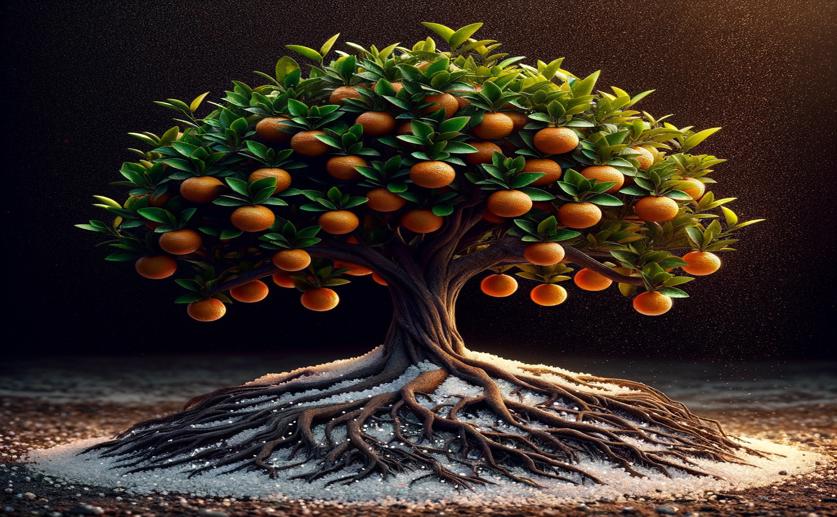Boosting Orange Tree Growth with Chitosan-Selenium Under Salt Stress

Image Source: Natural Science News, 2024
Key Findings
- The study by the University of Jiroft focused on improving the photosynthetic efficiency of Valencia orange plants under salt stress
- Salt stress significantly reduced chlorophyll, carotenoid, and SPAD values in the plants
- Applying a composite of chitosan and selenium nanoparticles improved photosynthetic pigments and efficiency, even under high salinity
Abiotic stress, such as salinity, significantly impacts the photosynthetic apparatus of plants. Recent research conducted by the University of Jiroft has investigated the potential of selenium nanoparticles (Se NPs), chitosan (CS), and their composite (CS + Se NPs) in enhancing the photosynthetic efficiency of Citrus sinensis (Valencia orange) under salt stress conditions[1]. This study builds on previous findings that have highlighted the benefits of chitosan in mitigating salt-induced stress in plants[2] and the potential of halophytes in improving salt tolerance through genetic means[3].
Salinity stress leads to a decline in the photosynthetic pigments and efficiency of plants. This study aimed to determine whether foliar applications of Se NPs, CS, and a combination of both could alleviate these adverse effects. The grafted seedlings of C. sinensis were exposed to varying levels of NaCl (0, 50, and 100 mM) to simulate moderate and intense salt stress. Following this, the plants were treated with distilled water (control), CS (0.1% w/v), Se NPs (20 mg L^-1), and CS + Se NPs (10 and 20 mg L^-1). Three months post-treatment, the researchers evaluated the levels of photosynthetic pigments, leaf gas exchange, and chlorophyll fluorescence in the treated plants.
The results demonstrated that salt stress significantly decreased total chlorophyll, carotenoid, and SPAD values by 31%, 48%, and 28% respectively. Moreover, the Fv/Fm ratio, an indicator of the maximum quantum efficiency of photosystem II (PSII), also decreased under salinity stress. However, the ratio of absorption flux (ABS), dissipated energy flux (DI0), and maximal trapping rate of PSII (TR0) to reaction centers (RC) increased, indicating an increase in the apparent antenna size of PSII.
Interestingly, the application of CS + Se NPs significantly improved the levels of photosynthetic pigments and the Fv/Fm value compared to plants treated with distilled water, under both moderate and intense salinity stress. This suggests that the composite treatment can sustain the photosynthetic ability of C. sinensis under salinity stress and mitigate its harmful effects on photosynthesis.
These findings align with earlier research that indicated chitosan's role in enhancing plant growth and mitigating salt stress by activating alternative respiration pathways and upregulating antioxidant enzymes[2]. Additionally, the study complements the understanding of how external treatments can improve plant resilience to salinity, similar to the genetic strategies employed by halophytes to thrive in saline environments[3].
In summary, the University of Jiroft's study provides compelling evidence that foliar application of a composite of chitosan and selenium nanoparticles can effectively counteract the negative impacts of salinity on the photosynthetic apparatus of C. sinensis. This approach offers a promising solution for improving crop resilience to salinity stress, thereby contributing to sustainable agriculture in salt-affected areas.
AgricultureBiochemPlant Science
References
Main Study
1) Improving the performance of the photosynthetic apparatus of Citrus sinensis with the use of chitosan-selenium nanocomposite (CS + Se NPs) under salinity stress.
Published 5th August, 2024
Journal: BMC plant biology
Issue: Vol 24, Issue 1, Aug 2024
Related Studies
Related Articles





 28th July, 2024 | Greg Howard
28th July, 2024 | Greg Howard